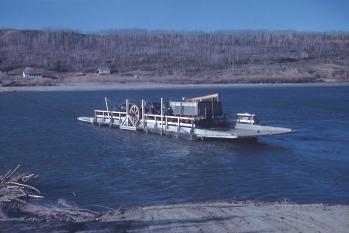
Ferries played a significant role in the early settlement and development of Saskatchewan. They not only provided transportation over the rivers, but also played a part in developing the economy by moving goods and providing employment: ferry service required operators and construction crews to undertake annual repairs and maintenance during the spring thaw when ice jams and flood waters damaged the ferries and riverbank landings. Saskatchewan's first known river ferry was operated and owned by the Hudson's Bay Company (HBC) near Fort Carlton in the 1860s. It was primarily responsible for hauling trade goods and HBC employees across the North Saskatchewan River during the summer months. In 1871 the first commercial ferry service was established by Xavier Letendre at Batoche on the South Saskatchewan River. It was also during this time that Gabriel Dumont, who later became famous for his participation in the North-West Resistance, started ferry service on the same river just south of Batoche, at a location appropriately named Gabriel's Crossing.
All ferry operators in Saskatchewan required a licence by 1875. Initially the licensing was granted through competition to the highest bidder, who received a three-year permit. This system resulted in expensive tolls, inefficient and unreliable service, and unsafe operating conditions. In 1898 the newly created Department of Public Works took over jurisdiction of ferry operations; operators were paid a salary, and set fees were established for the vessel's use. When Saskatchewan became a province in 1905, ferry service fell under provincial jurisdiction; by 1926 there were 47 ferries operating in the province. Many of these ferries were replaced by bridges during the 1930s and 1940s. Today, Saskatchewan Highways and Transportation operates and maintains twelve ferries and one barge. All ferry operations are seasonal, but generally take place from mid-April to mid-November depending on ice conditions. Ferry service is free; all ferries, except Wollaston and Riverhurst, are river crossings which operate from 7:00 a.m. to midnight (CST), predominantly in southern Saskatchewan (see Table FB-1).
Beyond road's end in northern Saskatchewan, a number of communities have had to rely on water transport as their means of receiving fuel, heavy goods (such as construction materials), and a wide range of retail supplies. As with communities along the Mackenzie River in the Northwest Territories, Saskatchewan settlements on the Athabasca River system (including Uranium City, Fond du Lac, Stony Rapids, and Black Lake) were serviced by barges pulled or pushed by tug boats; as many as four of these tug boats were used each season during the height of uranium and gold exploration and development in the 1950s. They were operated by Northern Transportation Company Limited (NTCL), a subsidiary of Eldorado Mining and Refining Company Ltd. (Eldorado had been created as a federal Crown corporation in 1944 to oversee strategic World War II interests related to uranium; it assumed ownership of a private mining company that included NTCL operations). NTCL was originally based at Waterways, Alberta (near present day Fort McMurray), where it could load barge freight targeted for both the Mackenzie and Athabasca river systems.
The silting waters of the Athabasca River were a constant source of grief for NTCL mariners and for the Canada Coast Guard, which was responsible for navigation aids and dredging on the northern river systems. Since 1997, the federal government has discontinued its dredging and navigational aids support for the Athabasca system; instead of maintaining the west-to-east Athabasca route for commercial water transport, it agreed to contribute to the cost of constructing a seasonal road from Points North (end of Highway 905) to Stony Rapids to provide an alternative re-supply route to the area. The seasonal road was completed in 2000, constructed and maintained by Saskatchewan Highways and Transportation. Winter ice roads and limited summer barge services from Stony Rapids are now used to ship goods east-to-west from Stony Rapids to Fond du Lac, Uranium City, and Camsell Portage. In 1982, Eldorado closed its operations at Uranium City: this resulted in a major reduction in freight shipping to the area. Since 1986, limited barge transport services to the area have been provided by private firms using smaller barges.
Barge service is also provided to the community of Wollaston Lake from Highway 905 during the summer and early fall. The community is situated on the eastern side of the lake, beyond the existing northern highway system. The motorized barge service was initiated by Co-op Fisheries Ltd. in 1974, primarily to enable trucks to haul fish from the company's Wollaston Lake packing facility to a processing plant in La Ronge. The service became used for general freight and vehicle transport, ownership being transferred to the provincial government in 1980. Saskatchewan Highways and Transportation has a contract with the Hatchet Lake First Nation to operate and maintain several transportation services for the community of Wollaston Lake, including the community airport, the continuing barge service, and a winter ice road across Wollaston Lake.
Brian Cousins, Daria Coneghan